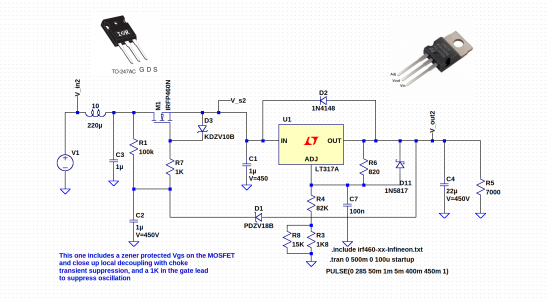I finally got my HV power supply working the way I want. While it had no measurable ripple it took a very long time to settle down. It behaved as a lightly damped oscillator, with a period of about 1 second. And if I imposed a brief load on the output it would again go into its damped oscillation.
This probably was due to a couple of things. My circuit simulations suggested that the loop gain was way too high -- not surprising, since the CCFL inverter can step 12V up to something on the order of 2KV (probably more, with no CCFL lamp loading it down). The other problem was that I've got three low-pass filter stages in there so the combination of lots of phase shift and high loop gain resulted in the poor gain margin. Three filter stages probably is overkill, but the Theremino folks really push the concept of very low HV supply ripple for the PMT.
My solution(s) included a nonlinear clamping circuit that in effect greatly reduces the loop gain once the control voltage to the inverter gets close to the necessary setpoint (determined by measuring it), and adding some lead compensation -- basically, adding some "D" to my PID-like HV controller. The latter was easy enough to do, since I had a high-pass RC filter on the controller board to monitor the output ripple.
With all this the output exhibits no overshoot and no low-frequency ringing. The next step is to modify the voltage divider on my PMT to make it compatible with the Theremino approach to things. This will require that I remove the bottom cap on the PMT/scintillator enclosure. I will follow
this procedure to do it. Hopefully the scintillator survives!
I took the other approach to losing the ripple and SMPSU noise, using much less capacitor and low pass energy storage filtering. The context was not as tricky as your need for 2kV, but much more modest for providing B+ voltage for some vacuum tube circuits. When it comes to easy switch-mode kit, there is a ton of choice, but near zero available at voltages above 48V. Those convenient (and cheap) Chinese SMPSU modules are so handy, but need to be followed by something to take out the ripple. I "regulate it away" by using high bandwidth linear regulators, fast enough to squish even the kHz noise.
To get my 135V (and up to 300V), I use the trick shown by
FesZ Electronics YouTube guy, by using a high voltage MOSFET ahead of a LM317-type regulator, such that the MOSFET takes the main task, and delivers a quite smooth pre-regulated input to the final 3-terminal regulator, which never sees any voltages across it exceeding it's ratings. The final regulator operates stood at a voltage high enough so that its main job is to be the noise ripple filter. When I used filter capacitors too large, it was capable of violent high voltage oscillation. I must have made a huge racket all over the HF bands!
You are absolutely right about the phase lags when it comes to heavy low pass filtering. Provided the filtering is entirely passive, that's all OK. Not so if the end result is being used to feed back to anything in control of what starts out. They add up to give you oscillation.
I also use the venerable TL431(s) as low noise artificial zeners, sometimes stacked, to reduce the division fraction of the voltage sampler potential divider. At 2KV, even 1Meg Ohm in the chain would get hot (4W). Getting a clean, low noise reference at some voltage nearer to the one you are trying to clean up is what I was after. The attached picture is what I used to make a 135V supply, with noise and ripple cleaned out, without blowing up the three-terminal regulator. They can only stand about 40V max. Beware, without
R7, you make a high power RF oscillator! Also, I added
D3 to keep Vgs sane
. It did not oscillate in simulation, but it sure did in actual build. Bursts of several hundred kHz, and maybe some MHz, all happening at an audio rate. R7 and D3 have yet to be tried in real build.

PS - Forgive the little images of the MOSFET and regulator. It helps me orient when I am trying to assemble it, and I am looking at the underside, to remember which is the gate, or the ADJ. As is, the circuit is no good for something like 2kV without R4, R8, R3 becoming exceptional, but I use it only for illustration of getting at the ripple without fat filters.



